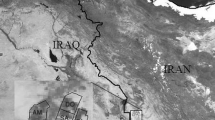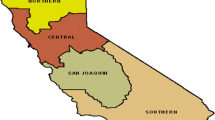Abstract
This paper describes a detailed evaluation of the performance and characteristic behaviour of feed-forward artificial neural network (ANN) and M5 model tree for estimating reference evapotranspiration (ET0) at four meteorological sites in an arid climate. The input variables for these models were the maximum and minimum air temperature, air humidity and extraterrestrial radiation. The FAO-56 Penman–Monteith model was used as a reference model for assessing the performance of the two approaches. The results of this study showed that the ANN estimated ET0 better than the M5 model tree but both models performed well for the study area and yielded results close to the FAO56-PM method. Root mean square error and R2 for the comparison between reference and estimated ET0 for the tested data using the proposed ANN model are 5.6 % and 0.98, respectively. For the M5 model tree method these values are 8.9 % and 0.98, respectively. The overall results are of significant practical use because the temperature and Humidity-based model can be used when radiation and wind speed data are not available.







Similar content being viewed by others
References
Allen RG, Smith M, Perrier A, Pereira LS (1994) An update for the definition of reference evapotranspiration. ICID Bulletin 43:1–34
Allen RG, Pereira LS, Raes D, Smith M (1998) Crop evapotranspiration: guidelines for computing crop requirements. FAOIrrigation and Drainage Paper No. 56. FAO, Rome, Italy
Atkinson PM, Tatnall ARL (1997) Introduction neural networks in remote sensing. Int J Remote Sens 18:699–709
Bhattacharya B, Solomatine DP (2005) Neural networks and M5 model trees in modeling water level–discharge relationship. Neurocomputing 63:381–396
Bhattacharya B, Solomatine DP (2006) Machine learning in sedimentation modelling. Neural Netw 19(2):208–214
Chauhan S, Shrivastava RK (2009) Performance evaluation of reference evapotranspiration estimation using climate based methods and artificial neural networks. Water Resour Manag 23(5):825–837
Coulibaly P, Anctil F, Bobee B (2000) Daily reservoir inflow forecasting using artificial neural networks with stopped training approach. J Hydrol 230(3–4):244–257
Droogers P, Allen RG (2002) Estimating reference evapotranspiration under inaccurate data conditions. Irrig Drain Syst 16:33–45
Hagan MT, Menhaj MB (1994) Training feedforward networks with the Marquardt algorithm. IEEE Trans Neural Netw 5:989–993
Hornik K, Stinchcombe M, White H (1989) Multilayer feedforward networks are universal approximators. Neural Netw 2:359–366
Irmak S, Allen RG, Whitty EB (2003) Daily grass and alfalfa reference evapotranspiration estimates and alfalfa-to-grass evapotranspiration ratios in Florida. J Irrig Drain Eng 129(5):360–370
Itenfisu D, Elliott RL, Allen RG, Walter IA (2000) Comparison of reference evapotranspiration calculations across a range of climates. Proceedings of the 4th National Irrigation Symposium. ASAE: Phoenix, AZ
Kumar M, Raghuwanshi NS, Singh R, Wallender WW, Pruitt WO (2002) Estimating evapotranspiration using artificial neural network. J Irrig Drain Eng 128(4):224–233
Mitchell TM (1997) Machine learning. The McGraw-Hill Comp. Press.
Odhiambo LO, Yoder RE, Hines JW (2001) Optimization of fuzzy evapotranspiration model through neural training with input–output examples. Trans ASAE 44(6):1625–1633
Pal M, Deswal S (2009) M5 model tree based modelling of reference evapotranspiration. Hydrol Process 23:1437–1443
Prechelt L (1998) Automatic early stopping using cross validation: quantifying the criteria. Neural Netw 11:761–767
Quinlan JR (1992) Learning with continuous classes. In Proceedings of the Fifth Australian Joint Conference on Artificial Intelligence, Hobart, Australia, 16–18 November, World Scientific, Singapore: 343–348
Rahimikhoob A (2010) Estimation of evapotranspiration based on only air temperature data using artificial neural networks for a subtropical climate in Iran. Theor Appl Climatol 101(1–2):83–91
Sarle WS (1995) Stopped training and other remedies for overfitting. In: Proceedings of the 27th symposium on the interface of computing science statistics
Sattari MT, Pal M, Apaydin H, Ozturk F (2013a) M5 model tree application in daily river flow forecasting in Sohu stream, Turkey. Water Resources 40(3):233–242
Sattari MT, Pal M, Yurekli K, Ünlukara A (2013b) M5 model trees and neural network based modelling of ET0 in Ankara, Turkey. Turk J Eng Environ Sci 37:211–219
Sattari MT, Nahrein F, Azimi V (2013c) M5 model trees and neural networks based prediction of daily ET0 (Case Study: Bonab Station). Iranian Journal of Irrigation and Drainage 7(1):104–113 (In Farsi)
Solomatine DP, Dulal KN (2003) Model trees as an alternative to neural networks in rainfall-runoff modelling. Hydrol Sci J 48(3):399–411
Solomatine DP, Xue Y (2004) M5 model trees compared to neural networks: application to flood forecasting in the upper reach of the Huai River in China. J Hydr Engrg 9(6):491–501
Sudheer KP, Gosain AK, Ramasastri KS (2003) Estimating actual evapotranspiration from limited climatic data using neural computing technique. Irrig Drain Eng 129(3):214–218
Tan Y, Van Cauwenberghe A (1999) Neural-network-based d-stepahead predictors for nonlinear systems with time delay. Eng Appl Artif Intell 12:21–25
Trajkovic S, Todorovic B, Stankovic M (2003) Forecasting of reference evapotranspiration by artificial neural networks. J Irrig Drain Eng 129(6):454–457
Utset A, Farre I, Martinez-Cob A, Cavero J (2004) Comparing Penman–Monteith and Priestley–Taylor approaches as referenceevapotranspiration inputs for modeling maize wateruse under Mediterranean conditions. Agric Water Manage 66(3):205–219
Wang Y, Witten IH (1997) Induction of model trees for predicting continuous lasses. In: Proceedings of the Poster Papers of the European Conference on Machine Learning. University of Economics, Faculty of Informatics and Statistics, Prague.
Witten IH, Frank E (2005) Data mining: practical machine learning tools and technique. Morgan Kaufmann Publishers, San Francisco
Zanetti SS, Sousa EF, Oliveira VPS, Almeida FT, Bernardo S (2007) Estimating evapotranspiration using artificial neural network and minimum climatological data. J Irrig Drain Eng 133(2):83–89
Acknowledgments
This study is the partial work under Project No. WR1-1389-631 supported by Sistan and Baluchestan Regional Water Corporation and was done in the Department of Irrigation and Drainage Engineering, Abouraihan Campus, University of Tehran.
Author information
Authors and Affiliations
Corresponding author
Rights and permissions
About this article
Cite this article
Rahimikhoob, A. Comparison between M5 Model Tree and Neural Networks for Estimating Reference Evapotranspiration in an Arid Environment. Water Resour Manage 28, 657–669 (2014). https://doi.org/10.1007/s11269-013-0506-x
Received:
Accepted:
Published:
Issue Date:
DOI: https://doi.org/10.1007/s11269-013-0506-x




